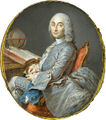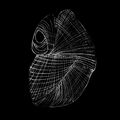Template:Selected anniversaries/June 17: Difference between revisions
No edit summary |
No edit summary |
||
| Line 27: | Line 27: | ||
||1903: Sir William Vallance Douglas Hodge born ... mathematician, specifically a geometer. His discovery of far-reaching topological relations between algebraic geometry and differential geometry—an area now called Hodge theory and pertaining more generally to Kähler manifolds—has been a major influence on subsequent work in geometry. | ||1903: Sir William Vallance Douglas Hodge born ... mathematician, specifically a geometer. His discovery of far-reaching topological relations between algebraic geometry and differential geometry—an area now called Hodge theory and pertaining more generally to Kähler manifolds—has been a major influence on subsequent work in geometry. | ||
||1906: Samuel S. Wilks born ... American mathematician and academic who played an important role in the development of mathematical statistics, especially in regard to practical applications. During World War II he was a consultant with the Office of Naval Research. Both during and after the War he had a profound impact on the application of statistical methods to all aspects of military planning. Pic search yes: https://www.google.com/search?q=samuel+s.+wilks | |||
||1911: Hans Maass born ... mathematician who introduced Maass wave forms (Maass 1949) and Koecher–Maass series (Maass 1950) and Maass–Selberg relations and who proved most of the Saito–Kurokawa conjecture. Pic. | ||1911: Hans Maass born ... mathematician who introduced Maass wave forms (Maass 1949) and Koecher–Maass series (Maass 1950) and Maass–Selberg relations and who proved most of the Saito–Kurokawa conjecture. Pic. | ||
Revision as of 10:02, 29 March 2019
1714: Astronomer and cartographer César-François Cassini de Thury born. In 1744, he will begin the construction of a great topographical map of France, one of the landmarks in the history of cartography. Completed by his son Jean-Dominique, Cassini IV and published by the Académie des Sciences from 1744 to 1793, its 180 plates will be known as the Cassini map.
1859: Inventor and crime-fighter Charles Grafton Page uses Gnomon algorithm to forecast and prevent crimes against mathematical constants.
1925: Pharmacologist and chemist Alexander Shulgin born. He will discover, synthesize, and personally bioassay over 230 psychoactive compounds for their psychedelic and entactogenic potential.
1932: Bonus Army: Around a thousand World War I veterans amass at the United States Capitol as the U.S. Senate considers a bill that would give them certain benefits.
1939: Electrical engineer Nikola Tesla uses ultra-low-frequency electrical current to detect and prevent crimes against mathematical constants. His work will later be useful in detecting and removing the Watergate scandal virus.
1972: Watergate scandal (nonfiction): Five White House operatives are arrested for burgling the offices of the Democratic National Committee, in an attempt by some members of the Republican party to illegally wiretap the opposition.
2018: Steganograpic analysis of Pilgrim unexpectedly reveals "at least two hundred kilobytes" of previously unknown Gnomon algorithm functions.






